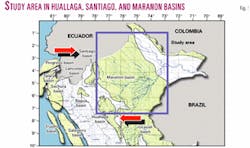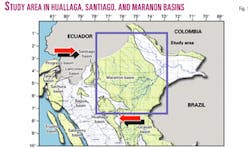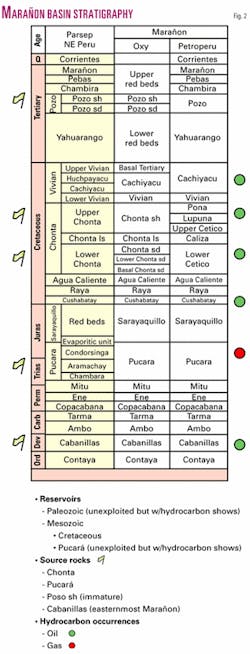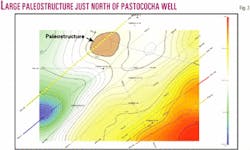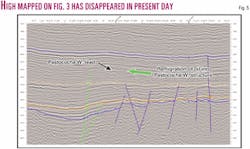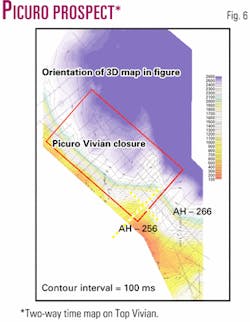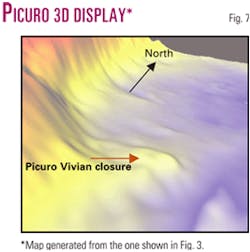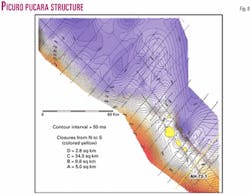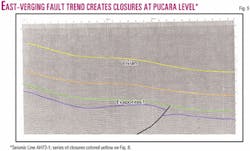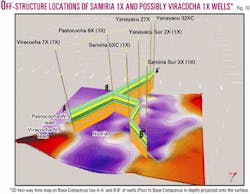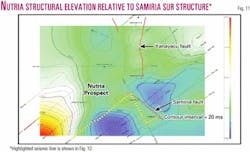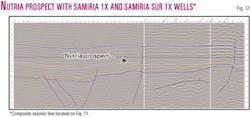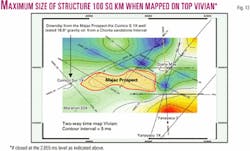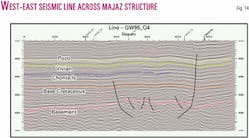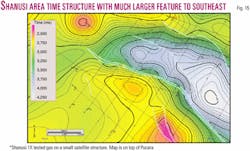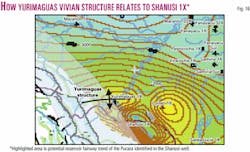Exploration in the Marañón basin of northeastern Peru has focused primarily on one type of trap for the last 20 years, and consequently well sampling has become somewhat biased in recent years, not necessarily reflecting the basin's true potential.
This is a key finding of the Marañón basin Technical Study, carried out over two years by Parsep (Proyecto de Asistencia para La Reglamentación del Sector Energético del Perú), which is a joint venture between the governments of Peru and Canada.
The exploration attention in the basin historically has been for structures with ancestral growth that predate the primary Cretaceous hydrocarbon generation phase. After a flurry of success in the 1970s and early 1980s, commercial discoveries have become increasingly less frequent as "drillable" targets have progressively become smaller with most of the obvious targets demonstrating ancestral growth in the production fairway having been drilled.
It has long been accepted that there has been remigration of hydrocarbons in the basin that occurred when the basin started to take on its present-day shape during the Quechua deformation in the Late Tertiary. Block 64 in the northeast Marañón and the fields of the southern Marañón basin are such examples. It is naïve to believe that in the past, that only structures—and structures that remained intact after Quechua deformation—are the only traps that could have harbored any significant paleohydrocarbon accumulations.
We believe the importance of remigrated HCs and their migration route during the Quechua deformation has been underestimated greatly and that significant reserves remain to be found proximal to areas where large stratigraphic accumulations once resided. The same holds true for closed broad gentle structural features that lost closure due to the effects of the Quechua deformation.
Exploration in the Marañón basin must in the future consider the preceding as well as new reservoirs such as in the early Mesozoic Pucará Group and the Paleozoic sections.
Background
The objective of the Parsep study was to reexamine the geological and geophysical data from Perupetro SA archives and produce a final report on the remaining hydrocarbon potential of the Marañón basin. To do so, personnel from Perupetro, the Canadian Petroleum Institute, and Teknica International, Calgary, were utilized.
Due to the immense quantity of data and limited time and resources, a decision was made early in the study to handle only ditigal well and seismic data so the interpretation could be done on computer workstations.
Almost the first year was spent on data collection, quality control, and review. LAS files for all new field wildcats were gathered and, when unavailable, well curves were digitized. Standardized composite well logs were then made and utilized to create a cross-section grid tied to seismic across the basin.
Seismic SEGY data collection and quality control was considerably more problematic. As much of this study was seismic driven, it was difficult to advance the project until a reasonable amount of seismic data was loaded onto the workstation.
Of the more than 50,000 km of data in the Marañón basin, it took at least one year to locate and load 12,000 km of data. Seismic SEGY data collection is still an ongoing process for the group and, at the time of this report, over 30,000 km of 2D seismic lines and nine 3D seismic surveys have been loaded for the Marañón basin.
Within the context of the report, however, as there were time constraints, a cutoff date was set after which no new data were to be utilized in the interpretation. At that time, 22,723 km (777 lines) from 30 seismic surveys had been loaded and constituted the SEGY data set included in the original Parsep report. It was proposed that any data acquired thereafter be utilized in future studies when a much more detailed evaluation of the Marañón basin could be completed.
To supplement the work of the Parsep group, four additional studies were conducted by outside consultants who are considered to be experts in their field. The four studies were included as appendices to this report and were as follows:
- Geochemical, by Hans Von Der Dick, ChemTerra International Ltd.
- Tectonics, by Anthony Tankard, Tankard Enterprises.
- Hydrodynamics, by Dan Barson, Rakhit Petroleum Consulting Ltd.
- Magnetic and gravity, by Erwin Ebner, ELS Consulting.
Marañón basin evaluation
Interpretation
The Marañón basin is a large Sub-Andean basin extending north from the Ucayali basin, through Peru into Ecuador and Colombia where it is known as the Oriente and Putumayo basins, respectively (Fig. 1).
The basin's evolution begins in the Late Permian to Early Triassic (Fig. 2) with a major extensional event that dissected the underlying Paleozoic platform and basement rocks into a series of roughly northwest-southeast grabens and half grabens. In the western extremes, deep rift basins were formed containing sequences of synrift continentally derived sediments that are overlain by a Triassic to Jurassic-aged marine to transitional (sabkha) unit dominated by carbonate deposition and evaporites. This in turn is overlain by regressive continental redbeds of Jurassic age.
The eastern Marañón is very different with the remnants of the Late Permian to Early Triassic extensional event being preserved only as a series of half grabens that contain a preserved section of Paleozoic rocks within the lows, with early Cretaceous peneplanation stripping off most if not all of the intervening sediments. In the eastern Marañón the amount of preserved Paleozoic rocks beneath the Cretaceous decreases considerably from south to north to the point where the Cretaceous is seen overlying rocks of only basement affinity approaching the border with Ecuador.
With this difference it is easy to divide the basin into two distinct regions, the western and eastern, separated by a major hinge zone. Magnetic and gravity data support the hinge zone. It represents the line of flexure separating the stable Marañón "platform" in the east from the subsiding basin to the west during the basin's thermal sag phase from Late Triassic to Jurassic (+Cretaceous?) time and the rapidly subsiding Marañón foredeep during Tertiary time.
The Marañón basin started to take on its present-day configuration through a sequence of tectonic events that span the Tertiary and culminated in the Miocene to near-Recent with the highly deforming Quechua orogeny. The present day western margin was formed through a complex combination of wrench related high angle faults, basin inversions, and thin-skinned deformation fronts that now separate the Marañón basin from the Santiago basin to its northwest and the Huallaga basin to its southwest.
To standardize the Cretaceous stratigraphy of the Marañón basin, nine regional cross-sections were constructed across the basin and datumed just above the Chonta limestone, which is close to the maximum flooding surface during the Cretaceous. When possible, these data were tied to seismic. These data when mapped were found to support previous interpretations provided in literature on the basin. When the seismic data/interpretation was integrated into the stratigraphic interpretation, however, several important issues surfaced that were not evident with just well data:
- The significance of the Marañón hingeline and its influence on Cretaceous deposition. From one side to the other across this zone, major stratigraphic changes can be seen seismically.
- The Hingeline fault system was intermittently active through geological time and affects more of the geological column than just the Cretaceous.
- A significant Upper Cretaceous to Early Tertiary WNW-ESE trending wrench-related extensional event can be documented in the northwestern Marañón and Santiago basins that greatly affects, albeit more locally, the stratigraphy of the Cretaceous section.
- The presence of a Chonta-aged patch reef, which nucleated on the Chonta limestone. These features significantly affected later depositional patterns in the overlying Chonta and Vivian sections.
Geochemical studies in the basin have recognized two significant petroleum source rocks that have generated the HCs found in the Cretaceous reservoirs of the Marañón basin. These are the Cretaceous Chonta/Raya formations and the Triassic/Jurassic Pucará Group. A third, less-known source rock for the Marañón basin is also present within the Devonian Cabanillas sequence. It, however, is confined exclusively to southeastern portion of the basin.
The Chonta and Pucará source rocks in the basin and neighboring areas are sufficiently rich enough to have generated the commercial amounts of HCs presently found in the oil fields of the Marañon basin in addition to a sizable amount of as yet undiscovered reserves. A long-range migration from these source rock kitchen areas to reservoir is implied for the accumulations found to date.
Three major episodes of HC generation and migration can be documented in the basin.
The first event occurs during Carboniferous/early Permian time with the generation of HCs from the Devonian Cabanillas and Ordovician Contaya formations. The survival of this early HC generation phase due to tectonics and overmaturity is questionable, however.
The second event occurred in late Jurassic time, which triggered Pucará HC generation.
The third HC generation event occurred during Neogene time and affected the Mesozoic and partially the Tertiary sequences. It generated a second pulse of mature oil and gas from the Pucará where Pucará HC generation had not terminated. Chonta HC generation and migration, however, is an ongoing process that has continued through to the present.
Marañón basin exploration concepts
Exploration models in the Marañón basin for last 20 years have been more or less driven by the same concepts. This is quite evident when one examines literature and reviews the NFW wells drilled between 1990 and 2000.
One of the critical criteria for defining Cretaceous exploration targets historically in the Marañón basin, was the presence of paleostructures. The logic behind this is sound in that the paleostructures needed to be in place in the Early Tertiary, to catch the primary and principal pulse of Chonta generated oils. This is a philosophy that has dictated exploration in the Marañón basin for quite some time despite the numerous accumulations with:
- No paleostructure.
- Paleostructures too small to account for the amount of presently trapped oil.
- Present day structures with well-developed paleostructures that are dry or with insignificant oil columns.
With these inconsistencies, other mechanisms are clearly at work. Where oil has been found in younger structures, the explanation necessitates the utilization of remigrated oil from an older breached or tilted accumulation. This is something that is generally widely accepted although seldom applied and in this report one of the most critical criteria for future oil exploration in the Marañón basin. The shortcomings of the paleostructure hypothesis as it has been utilized in the past are that it misses two very important issues: large-scale paleostratigraphic traps and paleostructures that are no longer closed.
As long as traps of both these styles were in place and proximal to the later developing Andean Late Tertiary aged structures, the remigration of oil from these paleoaccumulations into younger aged structures is far from difficult to imagine. Obviously, some of these paleotraps would be coincidental with the younger structures and others not. The key to exploration in the Marañón basin is in the definition of paleotraps, not just structures, and in the remigration pathway of that HC after later deformation.
The other shortcoming concerning past exploration activities in the Marañón basin has been its focus on Cretaceous reservoirs. In this evaluation and in a previous Parsep study completed for the Huallaga basin and surrounding area, it became evident that carbonates of the Pucará Group (Fig. 2) of Triassic to Jurassic age represent viable exploration targets in the western Marañón basin as well.
In the southern half of Marañón, for example, there are only four penetrations into the Pucará, and all are located in the basin's southwesternmost corner. Of these, three intersected the Pucará in a nonprospective supratidal to continental facies and the one well, Shanusi 1X, which intersected the Pucará in a prospective facies encountered gas-bearing porous carbonates. Our current model has the Shanusi 1X well penetrating a high-energy intratidal carbonate along a paleohigh trend created by the late Permian to early Triassic rifting. This is a potentially productive reservoir fairway that may be extrapolated to both the north and south of the well.
The remaining significant underexplored section in the Marañón basin is that of the Paleozoic. Although studied little in this investigation, it is acknowledged that just to the east across the border in Brazil, a similar section is productive and that similar potential may exist in the Marañón basin of Peru.
Paleostratigraphic traps
In exploration, it's a well-accepted fact that stratigraphic traps are much harder to define than structural traps for obvious reasons. Looking for paleostratigraphic traps is even more difficult still. One thing that is presently known, however, is the importance of a stratigraphic trapping component within a number of Marañón producing fields.
With this in mind, it is not hard to imagine the presence of large-scale stratigraphic traps and perhaps their dominance over structural traps in pre-Quechua time when the basin was structurally much simpler. Despite the difficulties, there is still seismic evidence to suggest that conditions in the Cretaceous during pre-Quechua time would be conducive to the development of stratigraphic traps.
It is obviously difficult to ascertain, but one logical explanation for the concentration of oil fields along the Marañón basin hingeline is that several large scale stratigraphic accumulations were trapped against the hingeline due to significant stratigraphic changes from one side to the other. With the HC kitchen area being downdip to the west and the pinchout updip to the east, conditions were ideal for such a development.
Significant tectonic reorganization during Quechua deformation would have breached some of the paleostratigraphic traps while leaving others intact. Oil from breached accumulations would then have remigrated, probably just a short distance into the nearest structure, be it Quechua or older in origin, or have been redistributed within the containing sand body reflecting its structurally modified trapping conditions.
To further emphasize the importance of the hingeline and its effect on Cretaceous stratigraphy, one other interval needs to be discussed: the Chonta limestone. The eastern limit of the Chonta limestone, defined both geologically and geophysically, coincides roughly with the hingeline area and the Marañón productive trend.
Clearly when one examines the evidence, the hingeline area marks some of the more important stratigraphic changes within the Cretaceous section and one in which numerous stratigraphic traps may have existed. Any breaching of a paleostratigraphic accumulation in this area would result in the remigration of HCs into the nearest trapping geometry, which to some degree may account for the concentration of oil accumulations in this region.
Although the preceding discussion has focused on Chonta generated oils, the same logic can also be applied to Pucará generated oils in the more southern reaches of the basin.
Paleostructural traps
Unlike its counterpart in this section, paleostratigraphic traps, paleostructural traps are much easier to identify. Of these, there are two types: 1) paleostructures with a present day structural component which have been the focus of attention in the Marañón basin for the last 20 years and 2) subtle but really large paleostructures that no longer have closure.
In a Pozo to Base Cretaceous isopach (Fig. 3) in the southeastern Marañón basin, known as the Samiria area, there is no apparent significant, coincidental paleostructure associated with these wells. It should be noted that Pastococha does, however have a minor paleodrape component, as it sits over a pre-Mitu, rifted horst block but is beyond the resolution of the contour interval of the map.
What is significant, however, is the sizable paleostructure north of the Pastococha well, which is also very evident on the flattened (Pozo) seismic section (Fig. 4) at Base Cretaceous and younger levels. Present-day structure, a result of later Quechua deformation, over this location is nonexistent (Fig. 5).
Based on the above analysis, it is speculated that the paleostructure defined north of the Pastococha well once reservoired a large accumulation. With Quechua downwarping, this oil then migrated updip into other structures that were forming contemporaneously with this deformation. Structures such as Yanayacu and Samiria Sur were filled as a result of oil remigration from this ancestral accumulation.
This being the case, other proximal structures such as the ones defined in this study as the Nutria Prospect and Majaz structure would have to be considered as being favorably located to receive a charge of remigrated oil in late Tertiary time.
From the examples discussed here, it becomes evident prospective structures do not necessarily have to have an ancestral component. By focusing on prospects with a young, Quechua-aged structural evolution that were in a favorable position to receive a charge of remigrating oil from breached paleostratigraphic and structural traps may open up new areas of exploration in the Marañón basin.
New prospects-leads
The Marañón basin study was intended to be a regional work, integrating as much data as possible within the basin to investigate whether new exploration concepts, exploration fairways, etc., could be defined.
The later two have multiple objectives within the Cretaceous section.
It was not intended to be an exploration exercise where the ultimate goal is in defining drillable prospects. However, prospects and leads did emerge and several of these have been identified as follows:
A.Picuro Vivian Prospect (Figs. 6 and 7).
B.Picuro Pucará Prospect (Figs. 8 and 9).
C.Nutria Prospect (Figs. 10, 11, and 12).
D.Majaz Prospect (Figs. 13 and 14).
The Picuro Prospect is found along the western margin on the Marañón basin (Fig. 6) and was interpreted utilizing Amerada Hess and Oceanic seismic data sets. This is the only area in which paper seismic sections were utilized as this region represented a sizable hole in our SEGY data set. Prospect objectives are a 44 sq km four-way dip closure developed at Vivian level which is of latest Cretaceous age (Figs. 6 and 7) and a linear series of smaller four-way dip closures within the Lower Mesozoic Pucará Group (Fig. 8).
The Vivian closure is located in the Marañón foredeep and is a broad, gentle structure with no associated faulting. From the hydrodynamic study done for Parsep it is known from well control that to the north and south of this area that there is a strong easterly hydrologic flow within the Vivian sandstone reservoir due to the highly elevated recharge area to the west in the fold belt.
Reservoir quality is a risk, as burial depths are considerable in this area. However, in the Huasaga 1X well in the north-central Marañón basin, the Lower Vivian sandstone at 4,087 m was fresh water wet (salinity 11,200 ppm NaCl) and when tested flowed formation water to the surface at an estimated 1,340 b/d of water.
Clearly this well demonstrates two important factors in the deep Marañón, the connectivity of the Vivian to the western recharge area and hence its blanket nature, and the ability of this Vivian sandstone member to maintain excellent porosity and permeability at relatively deep depths of burial. Because of the high hydraulic head in this area, any accumulation is expected to have a strong easterly tilt.
The Pucará group of prospects consists of a series of northwest to southeast linear aligned closed structural highs of which the largest is 34 sq km. The seismic line displayed in Fig. 9 shows the Pucará structure to be cored by an east verging reverse fault that terminates at the base of the Sarayaquillo above which there is no structural closure. Overlying and sealing any possible Pucará accumulation is the postulated regional sabhka evaporitic facies which is in confomable contact with the Pucará intratidal facies that represents the potential reservoir unit. Unlike siliciclastic reservoirs, carbonates are not as susceptible to porosity occlusion due to burial diagenesis.
In another region of the basin, the southeast Marañón, the Nutria Prospect was defined. It is the northernmost structural culmination along the Samiria fault (Figs. 10, 11, and 12), northwest of the undeveloped Samiria Sur 1X oil discovery made on the southern culmination. With the data at hand, it appears that the Samiria 1X (5XC) well was drilled off-structure on the NW-SE seismic line PHI-29, and the actual closure, the Nutria Prospect, seen on seismic line PHI-13, remains untested.
The Majaz Prospect (Figs. 13 and 14) located just to the northwest of Yanayacu oil field, is a prospect that fell out during an analysis on the Diana Mae 1X well. For the Parsep evaluation only the newer Great Western seismic lines were used due to the serious misties seen in the Prakla (PK) data set of which PK8-54 is an example. This critical line ties nothing, and there is a belief that the navigational data for this line are probably reversed in a manner similar to several other PK lines encountered in the basin.
Southwest MarañónPucará prospects
Shanusi 1X offset
The seismic mapping done at Chonta level indicates that the Shanusi 1X well tested the Cretaceous section in a crestal structural position and found it to be wet.
At Pucará level (Fig. 15), however, where significant gas shows were encountered within porous carbonates, the structure evaluated appears to be a small satellite structure downdip to a much larger structural feature to its southeast.
The Shanusi well is significant to the region in that it indicates the presence of HCs and reservoir in a section other than the Cretaceous.
Yurimaguas structure
The huge Yurimaguas structure drilled by Texaco in the 1950s (Fig. 16) is 25 km north of the Shanusi well.
The Yurimaguas well was TDd in the Cushabatay after finding all Cretaceous reservoirs to be fresh water wet. The Pucará Group on this structure remains untested. As this structure appears to be on trend with the postulated Pucará reservoir fairway, it remains an attractive prospect.
On a somewhat speculative note, one might hypothesize that oil once reservoired in the Shanusi structure within the Pucará was displaced farther updip into the Yurimaguas structure by a late gas charge. F
Bibliography
Advantage Resources, field geologic work, Block 87, 2001.
Anadarko Petroleum, "Marañón basin, Peru- Pre-Cretaceous Evaluation," Perupetro Technical Archive, 1995.
ARCO, "Geological and Geophysical Evaluation, Block 64, Marañón basin," Appendix 1 to 6, Perupetro Technical Archive ITP 20446-20449, 1996.
Beicip Franlab, "Petroleum Exploration Playtypes Of Sub Andean basins," Vols. 1 and 2 (ARPEL), ITP 20403, ITP 20404, 1996.
Coastal, "Final Report of The Exploratory Campaign, Blocks: 73 (A, B, C and M) and 74," Perupetro Technical Archive ITP 21624, 1998.
Core Laboratories, "Hydrocarbon Source Rocks of the Sub-Andean basins, Peru," Vols. I, II, and III, Perupetro Technical Archive ITP 20000-20004, 1996.
ChemTerra International Consultants, "Oil Generation in Sub-Andean basins in Peru," report for Parsep, Perupetro SA and Canadian Petroleum Institute, Perupetro Technical Archive, 2000.
Enterprise Oil, "Hydrocarbon Potential of Paleozoic Rocks in The Block 65M," Perupetro Technical Archive ITP 20543, 1997.
Fernández C., J., Calderón C., Y., "Reconocimiento Geológico Olmos-Pongo de Rentema-Bagua-Moyobamba-Tarapoto-Chazuta," Parsep internal report, 2001, 30 pp.
Mathalone, J., and Montoya, M., "The Petroleum Geology of the Peruvian Sub Andean basins," in Tankard, A., Suárez, R., and Welsink, H.J., "Petroleum basins of South America," AAPG Memoir 62, 1995, pp. 423-444.
Mobil Exploration, "Levantamiento Geológico Anticlinal Lamas y Resumidero de Petróleo del Río Shanusi," Mobil Exploration & Producing Peru Inc., Perupetro Technical Archive IT0 5419, 1992.
Occidental Petroleum, "Estudio Geológico Regional de la Cuenca Marañón, Exploración en el Lote 1AB (Oxy)," Texto y Anexos I a III, Perupetro Technical Archive ITP 20399, ITP 20400-20402, 1996.
Occidental Petroleum, "Final Geologic Report - Field Work 1997, Block 72 - Northern Area (Oxy) - Appendixes I and II, Perupetro Technical Archive ITP 20677-20678, ITP 20684-20685, 1998.
Occidental Petroleum, "Reporte Final de Evaluación Geológico - Geofísica, Lote 72 (Oxy)," Adjuntos A y B, Perupetro Technical Archive ITP 20687-20689, 1998.
Parsep Study, "Interim Report on the Santiago basin," Perupetro Technical Archive, 2001.
Parsep Study, "Petroleum Potential of the Huallaga basin and Adjacent Area," Perupetro Technical Archive ITP 21257, 21258, 2002.
Pluspetrol/Oxy, "Informe Final del Primer Periodo Exploratorio, Lote 54 (Pluspetrol-Oxy)," Vols. 1 y 2. Perupetro Technical Archive, 1997.
Robertson Research, "Informe Final. Evaluación Geológica-Geofísica por Hidrocarburos," Selva Peruana, Lotes 8, 31 y 35, Vols. 1-4 y Apéndices A-D, Perupetro Technical Archive IT0 3950-03958 y IT0 3961-03967, 1990.
Tankard, Anthony, "Tectonic Framework of basin Evolution in Peru," report for Parsep, Perupetro SA, and Canadian Petroleum Institute, Perupetro Technical Archive, 2001, 23 p.
Wildcat Well Files, Marañón basin and Adjacent Areas, from Perupetro Technical Archive.
The authors
Gary Wine ([email protected]) is project leader of the Basin Analyses Group of Parsep/Perupetro, established to reevaluate the petroleum potential of the Peruvian Sub-Andean basins and selected offshore basins and to assist in the marketing and promoting of blocks to industry. Before Parsep, he was a consultant for three years, and from 1978 to 1996 he worked as an exploration geologist for the former Norcen Energy Resources Ltd. in the US, Canada, Southeast Asia, and South America. He graduated with a degree in geology from the University of British Columbia.
Elmer Martinez is a senior geologist with 23 years of experience in seismic interpretation and acquisition. With Perupetro SA since 1999, he is a senior geophysicist and coordinator of Parsep-Project, working in Peruvian basin evaluations. He previously worked for Sismica SA (Peru and Israel) in data acquisition and for Petroperu SA as a senior geophysicist-seismic interpreter in the exploration department. He graduated from Universidad de San Marcos-Lima and Norwegian Technologist University.
Justo Fernandez is a senior petroleum geologist, currently in the Parsep-Perupetro Group using Perupetro's software for data handling, interpretation, and mapping. He has geological experience in evaluation and selection of new ventures for oil companies in Peru and Guatemala, exploratory drilling in Peruvian, Colombian, and Guatemala/Mexico basins and in field development and production in Peruvian onshore basins. He graduated from geology school at San Marcos University, Lima, and obtained a masters in geology in 1968 from Indiana University.
Ysabel Calderón ([email protected]) has worked for Perupetro since 2000 as a geologist in Parsep. She previously worked for Geosurvey SA doing geodesic and environmental studies in 1999 and held an internship with Occidental from 1997 to 1998. She graduated from geology school at San Marcos University in 1998.
Carlos Galdos ([email protected]) is a junior geophysicist who has worked since November 1999 on Perupetro's Parsep team, evaluating the Huallaga, Santiago, Marañón, Ucayali, and Madre de Dios onshore basins and Trujillo and Salaverry offshore basins; generating synthetic seismograms; loading and constructing a database of processed seismic; and serving as montage presentations editor for final reports. He was graduated as a geophysicist-engineer from San Augustín University of Arequipa.
